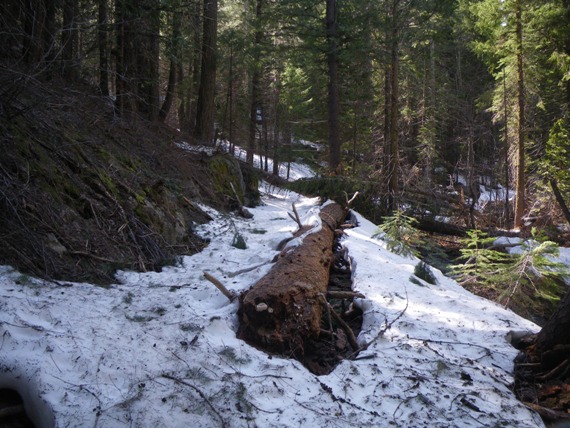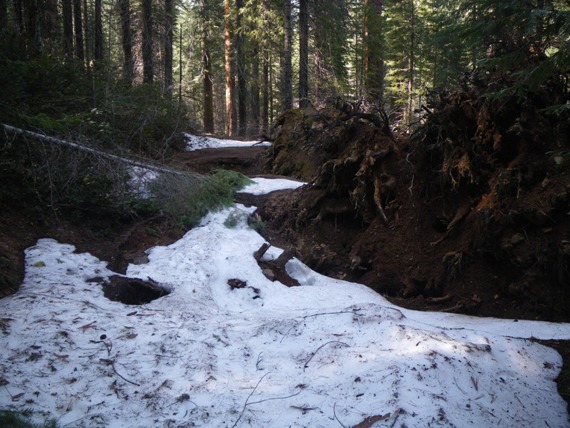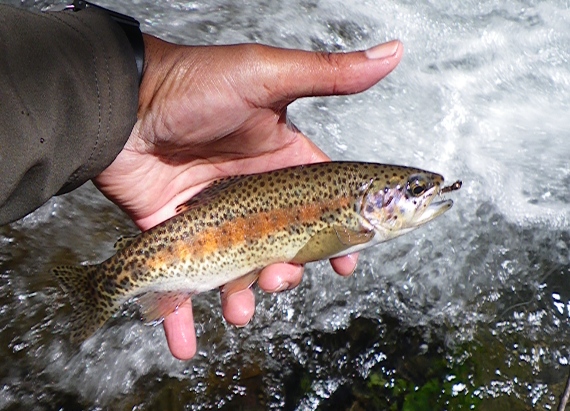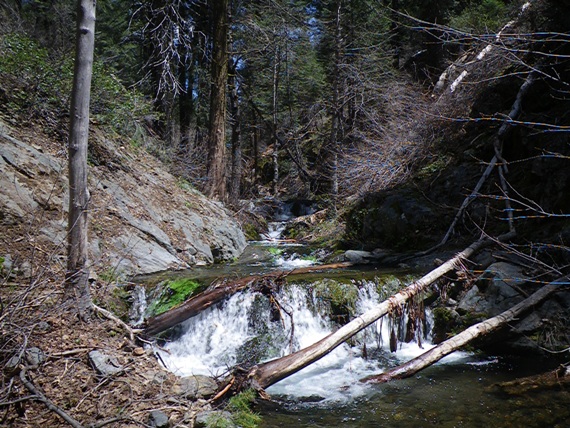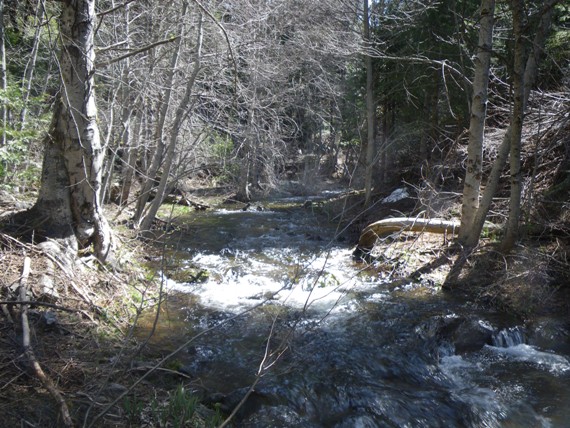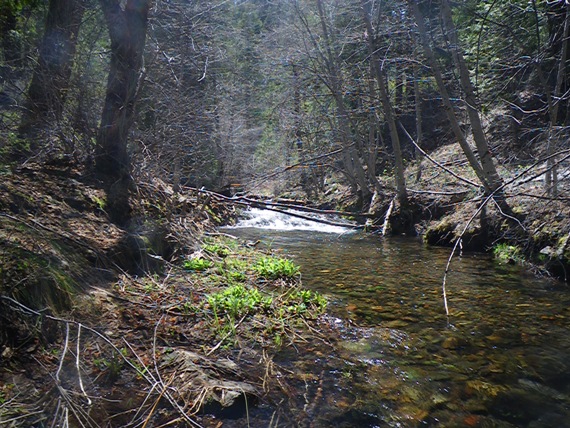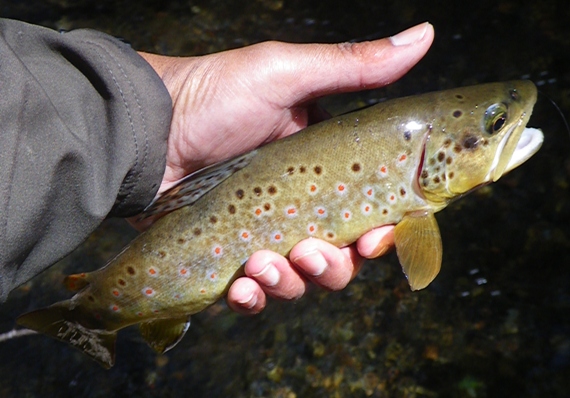|
|
|
|
|
May 8th 2010- Butterball Creek, Yosemite National Park Time:
11:00am to 3:30pm Narrative: The amount of fallen timber and snow along the trail this weekend is a real testament to the amount of snow pack we’ve had this year and of the late and extended high country season we should likely expect. This season marks the 9th that I’ve been fishing Butterball Creek and as I sat along its banks not catching fish for the first few hours, I had a lot of time to consider how it has changed over the years. First and most obvious, the trail isn’t as well maintained. There’s really nothing down in the canyon now except the stream. I suspect in the past there was some significance to the road that leads into the canyon. There was a structure over or around the creek of some sort that is simply a small stone retaining wall now. Two car sized holes caused by the root balls of fallen Incense Cedar trees now prevent any travel other than by foot and I suspect the park service has simply decided to let the trail return to it’s natural state. The trail is becoming overgrown and much of the fallen timber from last year remains. The stream itself has changed very little. The left fork, the "brown trout" fork, is of course more overgrown but still maintains the same character that it has always had. The right fork, the "rainbow trout" fork is always in a state of change. The tall pines along its steep banks are always threatening to fall into the stream and do; each year there’s always a sense of anticipation- wondering what tree has fallen in and dammed up a once insignificant run to create a monster trout pool. The stream has become more difficult to fish, not a huge surprise given that the more the streamside trees and bushes grow; the tougher it is to cast to some of the better runs. Seeing the change and knowing that the stream has likely been here longer than it has been known to man, makes me wonder…“Why isn’t it brushier?” The fish haven’t changed. I can still expect to find a fish or two in each likely spot and there are still a few bruisers for a stream of this size. The Browns do seem a tad skinnier but perhaps that’s due to last year’s low water or the introduction of rainbows in the “Brown Trout” fork. That’s a change -at least for me. The rainbows are possibly native coastal rainbows. The water that flows through the stream does eventually find its way to the California Delta. The question then becomes “are there any natural barriers to the main artery of the watershed to prevent fish from migrating up?” I can’t answer that.
If the rainbows are native, it’s curious that I’ve never caught a rainbow in the main portion of the stream until now. It wasn’t until last year that I actually caught a rainbow in the fork which I always knew held rainbows. Maybe the fish was pushed down the canyon by the water and will find the high summer water temperatures not to its likely. Browns tolerate high temperatures than rainbows generally do. That might cause the segregation. I really should visit sometime mid summer to see what things are like down there. I wouldn’t be surprised if I found it packed with rattlesnakes like the Tuolumne Canyon. When you fish alone in the backcountry and you’re not catching fish you have time to contemplate this and more. Making my way up the “Rainbow” fork, it became alarmingly obvious to me how isolated I was. Fallen timber littered the stream much like it did last week on North Green Creek but the rainbow fork is a bit different than North Green. North Green is essentially flat; the rainbow fork is in a V shaped canyon and all of the trees, even those high on the canyon wall, are essentially overhanging the stream. I thought back to the time Gino and I saw a tree come down over Pine Creek and wondered if a tree suddenly fell over, would I hear it over the running water? In a place were evasive action would be difficult to take, would it matter. Prudence, old age, call it what you will but that single thought probably saved the fishing day for me. I was really excited this week about fishing Butterball. Not only has it come to signify that my fishing season has truly started but I had new toys to try out. I had of course my “uber-rod”, the Stairway Creek 3wt taper to test out in new conditions but I would also be testing a new twisted leader that I had tied myself. Before coming, I read through several of my old Butterball Creek Chronicles. I knew I’d be a bit rusty but I was in the right frame of mind and wanted to give myself the best chance at success with the rod by avoiding past mistakes. The first part of the plan was not to arrive too early. Past experience has shown that the stream doesn’t fish well cold. It’s about 4 and one half hours from my home to the stream and my 6:22am departure time was later than I initially planned but worked out well. There was snow at the trailhead which isn’t too unusual. The stream is in a canyon at a slightly lower elevation and the snow at the trailhead usually disappears just out of sight of the parking lot. This wasn’t the case this year and there was snow on even the most exposed sections of the trail. Crunching through a couple feet of snow and climbing over fallen timber slowed my hike into the canyon. The upper portion of the stream comes into view about 30 minutes from the trailhead. Anyone familiar with the stream, with plans fish the upper portion, could do a lot worse than to fish it now. It’s much higher than normal and now would be the time to explore. I always start my fishing just below the confluence of the two forks of the stream. There’s a large pool that forms when these waters meet and a nice riffle below that. I took the water temperature as I ate, unpacked my gear and watching the water for “fish sign”. The thermometer read 42 degrees. I knew that at 43 degrees I had great fishing in the past. I made my first several casts from the left bank to several sections of the riffle and then moved immediately to the right bank. I commented last week that I like to cast from the left bank with my rod over the water and I do, when I’m aerial casting or roll casting, but when I bow and arrow cast, I like to have my line holding hand over the water in the clearest line of sight and this means casting from the opposite bank.
I was a bit disappointed to see the best part of the riffle covered by fallen tree branch. There is an innocuous looking pocket in the center of the riffle. To those that haven’t fished the stream before, it looks like the rest of the riffle, simply a small area that is several inches deep. In truth, it’s a big hole, at least 18 inches deep and something that you’d not like to accidentally wade into. It’s about 18 inches long, 12 inches across and a tree limb had fallen directly over and into it. Great for the fish but there was no way for me to get a fly in there. I fished up through the riffle to the pool without seeing a fish. The pool is usually someplace that you have to approach slowly. There are usually several fish in the tail that will dart up into the deeper water as you approach. Unfortunately, for several years there’s been a small tree that has grown to cover the tail and this year its branches had finally grown large enough to obstruct any casts one would try to send that way. This gave me little choice but to wade through the tail to a point were I could cast through the branches to the top of the pool. The right side of the pool buttress up against a large rock and I was able to use part of this as camouflage. I must have pounded this pool for an embarrassing long period of time. It always gives up a good fish but wasn’t doing so this day. I’d had several strikes and even a few hook ups but simply couldn’t keep anything on my line. I think next year instead of opting for the stealth of an upstream, over a rock and through the trees presentation, I’ll opt for the control of a short, from the bank, slightly downstream approach. I was fishless as I moved up into the “rainbow” fork of the stream. It was about this time that I realized I was cold. The air temps were dropping, yet another factor for me to work into my Butterball Creek fish catching formula. I looked up and it looked like a storm was brewing. I ignored it at first and concentrated on two fish that I found working in a small pool. I’ve pulled largish fish out of this particular pool before. In the past there had been some fallen timber that dammed up the outflow a bit to create nice deep pool. I had cast to 3 or 4 large fish, all of which were eager to have my fly for themselves. The fallen logs had since washed away and the “pool” had become simply a wide, slow, shallow run. With the water level up again, it was a pool again and I could see two fish on station. The scenario played out much as it had been all morning. I’d make a cast and either hang up or miss the strike. Eventually I’d hang up again and spook the fish, sending them under a rock. This was the last run where I usually catch Brown Trout and see black ants. Historically, from this point on, it’s smaller rainbows only. The browns like the ants, the rainbows the caddis cripple and hares ear nymph. I’d been switching between the ant dry and hares ear all morning. First I’d hit the fish with the dry and if that didn’t attract any strikes or I missed the hook up, I’d switch the nymph. I also missed the hook ups on the nymphs. Consistency surely counts for something….. somewhere….. Things didn’t change much with the rainbows. I made a cast to several pools and hooked several fish but couldn’t keep them on. It was about this time that I started to consider my environment. I’d reached a point where traveling up the canyon becomes very difficult during a normal water year. This year my standard crossing and climbing points were underwater. Then I noticed all the trees. I noticed again the weather and realized that I’d really have nowhere to go if a storm blew a tree in my direction while I was higher in the canyon. Another possible scenario that I'm just now considering is a flash flood. If a flash flood came rolling down the canyon it would be hard to escape and the fallen timber carried along with it would be deadly. I felt a bit strange. Not fear, not really concern but something in the back of my head that was telling me it would be prudent to turn around and so I did. At this point, if I had been on a High Sierra stream I would have probably headed back to the car. High Sierra storms are pretty consistent and I was seeing all the signs. Instead of heading straight out, I decided to fish the brown trout fork back to the trail. I moved quickly and made only a few casts to each pool as I went. I dropped my beadhead Hares Ear in the first brown trout pool and hooked a fish. It was off quickly but then I cast to another position and hooked a second fish and then in the tail, I saw a third fish in the pressure cushion of a small rock and hooked it as well. Finally, I landed a small 6 inch brown. Skinny, not great for this stream but I was pleased none the less. I landed a few more fish on the way to the trail. It was 2pm and I decided to scout upstream from where the trail crosses the creek. I sometimes fish this section first but was really expecting the better fishing to be downstream. I started seeing fish almost immediately and also noticed that some of the overhanging brush had been washed away. This is where the SWC rod really excels- in small tight streams were one can cast and make long roll casts. I’d made the decision earlier that it wasn’t suited to Butterball Creek in general. I felt the 3 additional inches that this rod has over the Young Midge, on the lower section of stream and as I tried to navigate the brush.
The runs in this section are longer. They generally have a deep plunge pool at the head and a long slower run at the tail. The pools are characteristically obstructed in some way, either by low brush or submerged timber but the tails are open and this combination allowed my little 3wt to place the flies exactly where I wanted them. On the first pool I started with a dry and again switched to the nymph when I missed the strike. The nymph was producing better so I kept it on. In the first run I picked up a small fish, much like that first brown. Crawling behind a tree, I saw a larger fish chase a smaller fish off a feeding station in the second run. I watched the fish to make sure it hadn’t been spooked by my approach and then made a bow and arrow cast a couple of feet above it. I watched the fish as my fly approached. The fish moved about 6 inches toward me. Since I was watching the fish and not my line, I didn’t register a take on the line and I couldn’t see my fly; instead I simply raised the rod. Fish on! It was a solid hook up and when I landed the fish, I was surprised to find it was an 8 or 9 inch rainbow trout with a nice violet stripe and olive back. I photographed and returned the fish and moved up to a run I know holds big fish. It’s a deep, dark run, with an undercut bank and two likely spots to catch big fish. The first is where the exposed roots of a tree stand in the water and protect the overhanging bank. The second is the plunge pool. I made a few token casts to the tree. It would be impossible to make an upstream cast that would allow the fly to travel far enough under the tree and deep enough to get the attention of the really big trout that must live there but I’d hope that maybe a curious fish might hear the plop of something falling in the water behind it shoot out for an easy meal. That didn’t happen. The plunge pool is usually shorter than it is now and casts are best made into it from the head. To do this I would have had to crawl around a second tree and since the plunge pool looked a bit bigger than normal I decided to shoot a cast at the seam behind which the frothing water meets the smooth. From high on the bank I made a good second cast, the nymph tucked as it entered the water and I knew it went deep fast. Before I could think “good cast” the line went tight. Big Fish! The fish shot forward for the plunge and I redirected it. Then it shot down to the exposed roots, I lowered my rod tip to the water and put a deep bend in the rod that pointed away from the roots. I was pretty sure I was going to loose the fish but as fate would have it I didn’t and landed a nice 12 inches brown.
I moved up to one of my favorite runs but as I sat on the bank enjoying the aroma of wild onions growing all around me, I decided to leave a little mystery for the next high water year. There are several runs upstream of this run that should fish very well at this level; I’d wait until the next high water year to discover just how well. I dug up an onion or two and chewed on them as I made my way back up the snow encrusted trail. I could tell from the snow that I had been the only person that ventured into the lower canyon that day. It’s amazing to think that there are hundreds of streams, like Butterball, that were planted with fish in the distant past and were, for the most part, forgotten about. Streams with wild and even native fish that may be undiscovered; water flows down a mountain, over rocks, through the trees largely unmolested by the world outside. Fish go about their daily lives, perhaps like a child, unaware that there is a world that exists beyond their experience until we, small stream fly fishers, venture forth to interrupt their solitude to find a little of our own. That thought fills me with wonder and appreciation.
Previous Yosemite / Ansel Adams
Wilderness Chronicle
|

